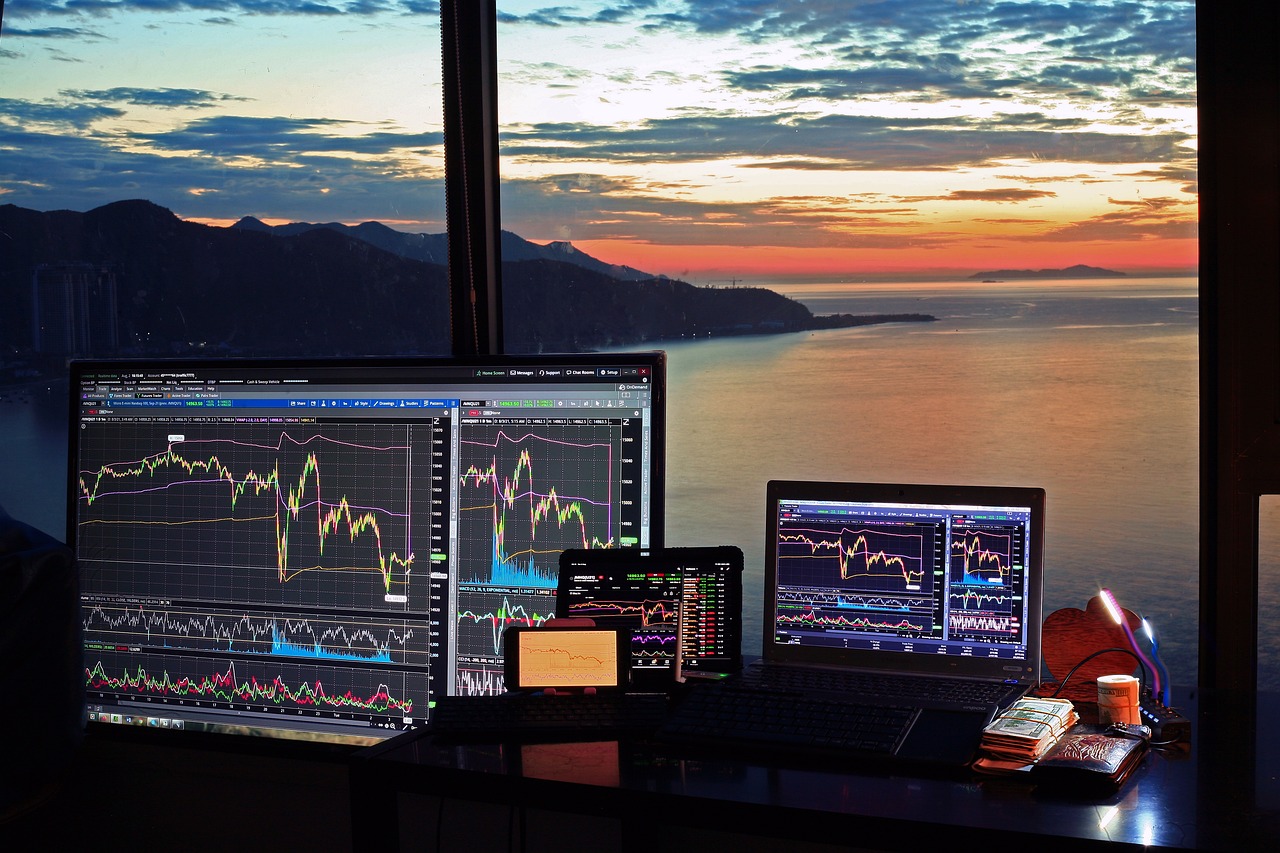Understanding the Impact of Market Liquidity on Trading
When we talk about market liquidity, we're diving into a key concept that can make or break trading strategies. Imagine trying to sell a hotcake at a busy market. If there's a line of eager buyers, you can sell it quickly without dropping the price. However, if you're the only one with a hotcake and no one seems interested, you might have to lower your price just to make a sale. This simple analogy illustrates the essence of market liquidity: the ease with which assets can be bought or sold without causing significant price changes.
In the world of trading, liquidity is not just a buzzword; it's a vital indicator of how smoothly transactions can occur. High liquidity means that traders can enter and exit positions with minimal price impact, while low liquidity can lead to wild price swings that can catch even seasoned investors off guard. Understanding this dynamic is crucial for anyone looking to navigate the financial markets effectively. It’s like having a roadmap in a city you’ve never visited before—without it, you might find yourself lost and frustrated.
Moreover, the implications of liquidity extend beyond individual trades. It affects overall market efficiency, ensuring that prices reflect all available information. When liquidity is abundant, the market can absorb new information swiftly, leading to more stable prices and a healthier trading environment. Conversely, during periods of low liquidity, the market may react irrationally to news, causing prices to spike or plummet unexpectedly. This unpredictability can be a trader’s worst nightmare, making it essential to monitor liquidity levels closely.
As we delve deeper into the factors influencing market liquidity, it's important to recognize that this concept is not static. It fluctuates based on various elements, including trading volume, the number of market participants, and prevailing economic conditions. For instance, during major economic announcements, liquidity can dry up as traders hesitate to make moves, fearing sudden market shifts. This behavior can create a feedback loop where low liquidity leads to high volatility, further discouraging trading activity. Understanding these patterns can empower traders to adjust their strategies proactively, ensuring they are always a step ahead in the game.
In conclusion, grasping the nuances of market liquidity is essential for any trader or investor. It’s about more than just buying and selling; it’s about understanding the environment in which these transactions occur. By keeping a pulse on liquidity trends, market participants can make informed decisions, navigate price volatility, and ultimately enhance their trading performance. So, the next time you enter the market, remember: liquidity is your ally. Use it wisely!
- What is market liquidity?
Market liquidity refers to the ease with which assets can be bought or sold in the market without affecting their prices.
- Why is liquidity important for traders?
Liquidity is crucial because it allows traders to enter and exit positions quickly, minimizing the risk of price fluctuations.
- How can I measure market liquidity?
Market liquidity can be measured using metrics such as bid-ask spreads and turnover ratios.
- What factors affect market liquidity?
Factors include trading volume, the number of market participants, and economic conditions.

The Concept of Market Liquidity
Market liquidity is a fundamental concept in trading that refers to the ease with which assets can be bought or sold in the market without causing a significant impact on their price. Imagine trying to sell a rare collectible; if there are many interested buyers, you can sell it quickly and at a good price. However, if there’s little interest, you might have to lower the price drastically or wait a long time to find a buyer. This scenario illustrates the essence of liquidity in the financial markets.
Understanding market liquidity is crucial for traders and investors alike. It affects not just the ability to enter or exit positions but also the overall efficiency of the market. In a highly liquid market, transactions can occur swiftly, and prices adjust more smoothly to new information. Conversely, in a market with low liquidity, even a small transaction can lead to substantial price fluctuations, creating an environment fraught with uncertainty.
Liquidity can be classified into two main types: market liquidity and funding liquidity. Market liquidity pertains to the ease of trading assets in the market, while funding liquidity refers to the availability of capital to finance these trades. Both types of liquidity are interconnected; when market liquidity dries up, it can lead to funding liquidity issues, creating a vicious cycle that can destabilize the entire market.
There are several indicators that traders use to gauge market liquidity. These include:
- Bid-Ask Spread: The difference between the highest price a buyer is willing to pay and the lowest price a seller will accept. A narrower spread often indicates higher liquidity.
- Trading Volume: The total number of shares or contracts traded within a given period. Higher volumes typically signify a more liquid market.
- Market Depth: The market's ability to sustain relatively large market orders without impacting the price of the asset significantly.
In summary, market liquidity is more than just a buzzword; it is a critical factor that influences trading strategies, investment decisions, and overall market health. By understanding liquidity, traders can better navigate the complexities of the market, optimize their strategies, and ultimately enhance their chances of success.
What is market liquidity?
Market liquidity refers to the ease with which assets can be bought or sold without causing a significant change in their price. A liquid market allows for quick transactions with minimal price impact.
Why is liquidity important for traders?
Liquidity is vital for traders because it directly affects their ability to enter and exit positions. High liquidity means trades can be executed quickly, reducing the risk of slippage and price volatility.
How can I measure market liquidity?
Market liquidity can be measured using various metrics, such as bid-ask spreads, trading volume, and market depth. These indicators help traders assess the trading environment and make informed decisions.
What happens in a low liquidity market?
In a low liquidity market, even small trades can lead to significant price changes, resulting in increased volatility. This can make it challenging for traders to execute their strategies effectively.

Factors Influencing Market Liquidity
Market liquidity is not a static concept; it fluctuates based on various factors that can significantly affect how easily assets can be traded. Understanding these factors is crucial for traders and investors alike, as they can help anticipate shifts in liquidity and adjust strategies accordingly. One of the most significant influences on market liquidity is trading volume. When a high number of shares or contracts are traded, it generally indicates a more liquid market. This is akin to a bustling marketplace where buyers and sellers are actively engaging, leading to quicker transactions and less price impact.
Another critical factor is the number of market participants. A diverse mix of buyers and sellers enhances liquidity, as it creates a more competitive environment. Think of it like a crowded party—more people mean more conversations and interactions, which makes it easier to find someone to trade with. Conversely, in a market with few participants, it can be challenging to execute trades without causing significant price changes.
Moreover, economic conditions play a pivotal role in shaping market liquidity. For instance, during times of economic uncertainty or crisis, traders may become more hesitant to buy or sell, leading to decreased liquidity. This situation can be likened to a game of musical chairs, where players are reluctant to move, resulting in fewer transactions and greater price volatility. On the other hand, in a stable economic environment, liquidity tends to increase as confidence returns to the market.
Additionally, the regulatory environment can impact liquidity significantly. Changes in regulations can either enhance or restrict trading activity. For example, if new rules are introduced that make trading more complex or costly, market participants may pull back, leading to lower liquidity. On the flip side, regulatory measures that promote transparency and reduce trading costs can encourage more participation, thereby enhancing liquidity.
Lastly, technological advancements have revolutionized how markets operate, influencing liquidity as well. The rise of algorithmic trading and high-frequency trading has increased the speed and efficiency of transactions. This technological shift can be visualized as a well-oiled machine, where everything runs smoothly and quickly, leading to increased liquidity. However, it can also create challenges, as rapid trading can lead to sudden price swings if not managed properly.
In summary, the interplay of trading volume, market participants, economic conditions, regulatory frameworks, and technology all contribute to the dynamics of market liquidity. By keeping an eye on these factors, traders can better navigate the complexities of the market and make informed decisions that align with their trading strategies.

The Role of Market Makers
Market makers are the unsung heroes of the trading world. They provide the necessary liquidity that keeps the financial markets flowing smoothly. Imagine a bustling marketplace where buyers and sellers are constantly negotiating prices. In this scenario, market makers act as the facilitators, ensuring that there’s always someone willing to buy or sell an asset. This role is crucial because it helps to minimize the bid-ask spread, which is the difference between the price a buyer is willing to pay and the price a seller is asking for. A narrower spread indicates a more liquid market, which is beneficial for all participants.
But how do market makers maintain this liquidity? They do so by continuously providing buy and sell quotes for various securities. This means that even if there aren’t any immediate buyers or sellers, the market maker steps in to fill the gap. By doing this, they help to stabilize prices and reduce the risk of extreme volatility. Without market makers, we would likely see much larger price swings, making trading a far riskier endeavor.
Market makers can be divided into two main categories: institutional market makers and retail market makers. Institutional market makers are typically large financial firms that have the resources to absorb significant amounts of trading volume. They often engage in complex strategies and algorithms to manage risk and optimize their trading positions. On the other hand, retail market makers cater to individual traders, providing them with the ability to trade without having to wait for a counterparty. Each type of market maker plays a unique role in the ecosystem, contributing to overall market efficiency.
Moreover, market makers employ various strategies to navigate the complexities of the financial markets. For instance, they might use automated trading systems to quickly adjust their quotes based on market conditions. This adaptability is crucial, especially during periods of high volatility or when significant economic news is released. By being proactive, market makers can mitigate risks and ensure that they are providing liquidity even in challenging environments.
In summary, market makers are essential for the health of the trading ecosystem. Their ability to provide liquidity not only facilitates smoother transactions but also contributes to price stability. By understanding the role of market makers, traders can better navigate the complexities of the market and make more informed decisions.
- What is a market maker?
A market maker is a firm or individual that provides liquidity in the financial markets by continuously offering to buy and sell securities. - How do market makers make money?
Market makers profit from the spread between the buying price and the selling price of securities, as well as from trading volume. - Why is liquidity important in trading?
Liquidity ensures that assets can be quickly bought or sold without significantly affecting their price, which is vital for efficient trading. - Can market makers cause price volatility?
While market makers help stabilize prices, sudden changes in their quoting behavior or market conditions can lead to increased volatility.

Types of Market Makers
When it comes to understanding market liquidity, it's essential to recognize the different types of market makers that operate within the financial ecosystem. Each type plays a unique role and employs distinct strategies to ensure the smooth functioning of markets. Broadly, we can categorize market makers into two main types: institutional market makers and retail market makers.
Institutional market makers are typically large financial institutions or firms that have the resources and technology to facilitate substantial trading volumes. They provide liquidity by continuously offering buy and sell quotes for a variety of securities, including stocks, bonds, and derivatives. Their presence is crucial during periods of high volatility, as they help stabilize prices by absorbing excess supply or demand. These market makers often use sophisticated algorithms and high-frequency trading strategies to manage their positions and minimize risk.
On the other hand, retail market makers are smaller firms or individual traders that operate on a much smaller scale. They primarily serve retail investors and often provide liquidity in less liquid markets. While they may not have the same level of resources as institutional players, retail market makers still contribute to overall market efficiency by ensuring that individual investors can buy and sell securities without significant price impact. Their strategies may include less complex algorithms and a more hands-on approach to trading.
To illustrate the differences further, let's take a look at a simple comparison table:
| Type of Market Maker | Characteristics | Impact on Liquidity |
|---|---|---|
| Institutional Market Makers | Large firms, high trading volume, sophisticated technology | Provide significant liquidity, stabilize prices, absorb volatility |
| Retail Market Makers | Small firms or individual traders, lower trading volume | Facilitate trades for retail investors, enhance market access |
Understanding these types of market makers is vital for traders and investors alike. By recognizing who is providing liquidity in the market, participants can better gauge the potential impact on their trading strategies. For instance, during times of economic uncertainty, the presence of institutional market makers can lead to more stable prices, while the activities of retail market makers can provide opportunities for smaller investors to engage in trading without facing excessive slippage.
In conclusion, the landscape of market makers is diverse, with each type contributing to the overall liquidity and efficiency of the financial markets. By understanding the nuances between institutional and retail market makers, traders can make more informed decisions, ultimately enhancing their trading strategies and outcomes.
- What is a market maker? A market maker is a firm or individual that provides liquidity to the market by continuously offering buy and sell quotes for securities.
- Why are institutional market makers important? They help stabilize prices during volatile periods and absorb excess supply or demand, ensuring smoother market operations.
- Can retail investors benefit from retail market makers? Yes, retail market makers facilitate trades for individual investors, providing access to markets that may otherwise be challenging to navigate.

Market Maker Strategies
Market makers are the unsung heroes of the trading world, working tirelessly behind the scenes to ensure that buying and selling assets is as smooth as possible. Their strategies are not just about making a quick buck; they involve a complex interplay of risk management, pricing algorithms, and market analysis. One of the primary strategies employed by market makers is the spread management. This involves setting the bid-ask spread—essentially the difference between what buyers are willing to pay and what sellers are asking. A tighter spread often indicates higher liquidity, making it easier for traders to enter and exit positions without significant price impacts.
Another key strategy is inventory management. Market makers need to maintain a balanced inventory of assets to avoid exposure to price fluctuations. They achieve this by constantly adjusting their quotes based on market conditions. For instance, if a particular stock sees a surge in demand, a market maker might raise the ask price to manage their exposure and ensure they are not caught off guard by a sudden price spike. This balancing act is crucial; if they hold too much inventory, they risk losing money if the market turns against them.
Moreover, market makers often employ algorithmic trading strategies. These algorithms analyze vast amounts of market data in real-time, allowing market makers to make split-second decisions that human traders might miss. For example, if an algorithm detects a sudden influx of buy orders, it can automatically adjust prices to capitalize on the increased demand, thereby maintaining liquidity. This not only benefits the market maker but also enhances overall market efficiency.
Additionally, arbitrage opportunities play a significant role in market maker strategies. By simultaneously buying and selling the same asset in different markets, market makers can profit from price discrepancies. This strategy requires a keen eye for detail and quick execution, as these opportunities can vanish in the blink of an eye. It's much like spotting a rare bird in a forest; if you hesitate, it might just fly away!
In conclusion, the strategies employed by market makers are multifaceted and essential for maintaining market liquidity. They utilize a combination of spread management, inventory balancing, algorithmic trading, and arbitrage to navigate the complexities of the market. By understanding these strategies, traders can gain valuable insights into liquidity fluctuations and make more informed decisions.
- What is a market maker? A market maker is a financial intermediary that provides liquidity to the market by continuously buying and selling assets.
- How do market makers influence liquidity? Market makers enhance liquidity by narrowing the bid-ask spread and facilitating smoother transactions, which helps stabilize prices.
- What is the role of algorithms in market making? Algorithms help market makers analyze market data quickly and make real-time trading decisions to optimize liquidity and minimize risks.
- Can market makers lose money? Yes, market makers can incur losses, especially if they mismanage their inventory or fail to adjust their strategies in response to market changes.

Impact of Economic Events on Liquidity
The world of trading is akin to a finely tuned machine, where every cog and wheel must work in harmony. One of the most significant factors that can throw a wrench into this machine is economic events. These events, ranging from earnings reports to geopolitical tensions, can create waves that ripple through the market, affecting liquidity in profound ways. When we talk about liquidity, we essentially refer to how easily assets can be bought or sold without causing drastic price changes. So, how do economic events influence this critical aspect of trading?
For starters, consider the impact of earnings reports. When a company releases its quarterly earnings, traders flock to buy or sell shares based on the results. A positive earnings surprise can lead to a surge in buying interest, while disappointing results can trigger a sell-off. This sudden influx or outflow of orders can create a temporary liquidity crunch, as the market struggles to accommodate the rapid changes in demand. In such cases, the bid-ask spread may widen, reflecting the increased uncertainty among traders.
Another crucial economic event that can affect liquidity is a change in interest rates. When central banks decide to raise or lower rates, it sends shockwaves through the financial markets. Higher interest rates often lead to decreased borrowing and spending, which can reduce the overall activity in the market. Conversely, lower rates tend to stimulate economic growth, encouraging more trading activity. This fluctuation in market participation can lead to significant changes in liquidity levels.
Geopolitical events, such as elections, trade disputes, or natural disasters, also play a pivotal role in shaping market liquidity. For instance, during periods of uncertainty, such as an impending election, traders may adopt a more cautious approach, leading to lower trading volumes. In such scenarios, liquidity can dry up, making it harder for traders to execute their strategies effectively. The market becomes a bit like a crowded room that suddenly goes silent; the atmosphere becomes tense as participants wait for clarity.
To illustrate the impact of these economic events on liquidity, consider the following table that highlights different types of events and their potential effects:
| Economic Event | Potential Impact on Liquidity |
|---|---|
| Earnings Reports | Increased trading volume, potential liquidity crunch |
| Interest Rate Changes | Decreased or increased market activity, affecting liquidity |
| Geopolitical Events | Reduced trading volumes, increased bid-ask spreads |
In summary, economic events are like the weather in the trading world; they can change rapidly and have a significant impact on liquidity. Traders who stay informed about these events and their potential implications can better navigate the turbulent waters of the market. By understanding how these factors interact, they can adjust their strategies accordingly, ensuring they remain agile and responsive to the ever-evolving landscape of trading.
- What is market liquidity?
Market liquidity refers to the ease with which assets can be bought or sold in the market without causing a significant change in their price. - How do economic events affect trading strategies?
Economic events can lead to sudden changes in market conditions, prompting traders to adjust their strategies to mitigate risks and seize opportunities. - Why is understanding liquidity important for traders?
Understanding liquidity helps traders make informed decisions, manage risks, and optimize their trading strategies based on market conditions.

Liquidity and Price Volatility
When we talk about liquidity and price volatility, we're diving into a fascinating relationship that can make or break trading strategies. Imagine a bustling marketplace where goods are exchanged swiftly; this is what high liquidity looks like. In such an environment, prices remain stable, and everyone walks away satisfied. However, picture a deserted marketplace, where every transaction takes time and effort—this is akin to low liquidity, where prices can swing wildly, leaving traders in a state of confusion.
The connection between liquidity and price volatility is straightforward: generally, the more liquid a market is, the less volatile it tends to be. When there are plenty of buyers and sellers, assets can be traded without significant price changes. For instance, think about a stock that has a high trading volume; it's like a well-oiled machine where buyers and sellers find each other easily, leading to smooth transactions. On the flip side, in a market with low liquidity, even a small trade can cause a dramatic price shift. This is because there aren’t enough participants to absorb the trade without impacting the price.
To illustrate this relationship further, consider the following table that summarizes how liquidity affects price volatility:
| Liquidity Level | Price Volatility | Market Impact |
|---|---|---|
| High Liquidity | Low Volatility | Stable prices, easier to enter/exit positions |
| Medium Liquidity | Moderate Volatility | Some price fluctuations, potential for slippage |
| Low Liquidity | High Volatility | Sharp price changes, increased trading risk |
Traders need to be acutely aware of this relationship when formulating their strategies. For instance, if a trader anticipates a period of low liquidity—perhaps due to a holiday or a major economic announcement—they might adjust their positions accordingly. This could mean tightening stop-loss orders or even sitting on the sidelines until the market stabilizes.
Moreover, understanding liquidity and its impact on volatility can also help traders identify opportunities. In times of low liquidity, while the risks are higher, the potential for profit can also increase if one can navigate the choppy waters effectively. It’s like surfing; the bigger the wave, the more thrilling the ride, but it also requires skill and timing to stay on top.
In conclusion, the interplay between liquidity and price volatility is a critical consideration for anyone involved in trading. Recognizing the signs of changing liquidity can empower traders to make informed decisions, adjust their strategies, and ultimately enhance their chances for success in the ever-evolving financial markets.
- What is market liquidity? Market liquidity refers to the ability to buy or sell assets quickly without causing a significant change in their price.
- How does liquidity affect trading strategies? High liquidity generally allows for smoother transactions and less price volatility, which can influence when and how traders enter or exit positions.
- Can low liquidity be beneficial? While low liquidity increases risk, it can also present opportunities for traders who can manage the volatility effectively.
- What are common indicators of liquidity? Common indicators include bid-ask spreads, trading volume, and turnover ratios.

Measuring Market Liquidity
When it comes to trading, understanding market liquidity is not just a theoretical exercise; it's a practical necessity. But how do traders and investors measure this elusive concept? There are several key metrics that can provide insights into the liquidity of a market. The most commonly used indicators include bid-ask spreads, turnover ratios, and depth of market. Each of these metrics offers a unique lens through which to view liquidity, helping traders make informed decisions.
The bid-ask spread is perhaps the most straightforward measure of liquidity. It represents the difference between the highest price a buyer is willing to pay (the bid) and the lowest price a seller will accept (the ask). A narrow spread indicates a liquid market, where transactions can occur quickly and with minimal price impact. Conversely, a wider spread suggests a less liquid market, where buying or selling can significantly affect prices. For example:
| Market Condition | Bid Price | Ask Price | Bid-Ask Spread |
|---|---|---|---|
| Liquid Market | $50.00 | $50.05 | $0.05 |
| Illiquid Market | $50.00 | $51.00 | $1.00 |
Another important metric is the turnover ratio, which measures the volume of trading activity relative to the total number of outstanding shares. A high turnover ratio indicates a high level of trading activity, which typically correlates with greater liquidity. This ratio can be calculated using the following formula:
Turnover Ratio (Total Volume of Shares Traded) / (Total Outstanding Shares)
For instance, if a company has 1 million shares outstanding and sees 250,000 shares traded in a day, the turnover ratio would be 0.25, or 25%. This suggests a reasonably liquid market for that stock.
Lastly, the depth of market is another vital indicator. It refers to the market's ability to sustain large orders without significant price changes. Depth can be assessed by looking at the order book, which displays the number of buy and sell orders at various price levels. A market with significant depth means that large trades can be executed without drastically affecting the price, making it a more attractive option for traders.
In summary, measuring market liquidity involves a combination of metrics that provide a comprehensive view of the trading environment. By analyzing bid-ask spreads, turnover ratios, and market depth, traders can gauge liquidity levels and adjust their strategies accordingly. As the saying goes, "knowledge is power," and in the world of trading, understanding liquidity can be the key to success.
- What is market liquidity? Market liquidity refers to the ease with which an asset can be bought or sold in the market without affecting its price.
- Why is measuring liquidity important? Measuring liquidity is crucial because it helps traders understand how easily they can enter or exit positions, which affects their trading strategies and risk management.
- What does a narrow bid-ask spread indicate? A narrow bid-ask spread typically indicates a liquid market, where transactions can occur quickly with minimal price impact.
- How can I improve my understanding of market liquidity? You can improve your understanding by studying various liquidity metrics, following market news, and practicing trading strategies in different market conditions.

Liquidity Risk Management
Liquidity risk management is a critical component of trading strategies, especially in today's fast-paced financial markets. It involves identifying, assessing, and mitigating the risks associated with the inability to buy or sell assets without causing a significant impact on their price. Imagine trying to sell a rare collectible at an auction; if there aren't enough interested buyers, you might have to lower your price drastically. This analogy illustrates the essence of liquidity risk—if there's no one to buy when you want to sell, you could face substantial losses.
One of the primary strategies for managing liquidity risk is portfolio diversification. By spreading investments across various asset classes, sectors, and geographical regions, traders can reduce the impact of a liquidity shortage in any single market. For instance, if you invest solely in a niche market that suddenly dries up, you might find it challenging to exit your position. However, if your portfolio includes a mix of stocks, bonds, and commodities, you may find more opportunities to liquidate your assets when needed.
Another effective approach is the use of stop-loss orders. These orders automatically sell an asset when it reaches a predetermined price, helping to limit potential losses during periods of low liquidity. Think of it as a safety net that activates when the market takes a downturn. By setting stop-loss orders, traders can protect themselves from sudden price drops that might occur when liquidity is scarce.
Moreover, traders should also monitor market conditions closely. Economic indicators, such as interest rate changes or geopolitical events, can significantly affect liquidity. For example, during times of economic uncertainty, investors may pull back from trading, leading to decreased liquidity. By staying informed and adapting strategies accordingly, traders can better navigate these fluctuations.
To illustrate the importance of liquidity risk management, consider the following table that outlines common strategies and their potential benefits:
| Strategy | Benefits |
|---|---|
| Portfolio Diversification | Reduces exposure to any single asset's liquidity risk |
| Stop-Loss Orders | Limits potential losses during market downturns |
| Market Monitoring | Enables timely adjustments to trading strategies |
In conclusion, effective liquidity risk management is essential for traders looking to protect their investments and navigate the complexities of the market. By employing a combination of strategies such as diversification, stop-loss orders, and vigilant market monitoring, traders can significantly mitigate the risks associated with liquidity shortages. Remember, in the world of trading, being prepared is half the battle!
- What is liquidity risk? Liquidity risk refers to the risk that an asset cannot be bought or sold quickly enough in the market without affecting its price.
- How can I manage liquidity risk? You can manage liquidity risk by diversifying your portfolio, using stop-loss orders, and staying informed about market conditions.
- Why is liquidity important in trading? Liquidity is crucial because it affects the ability to execute trades quickly and at favorable prices. Low liquidity can lead to increased volatility and potential losses.
Frequently Asked Questions
- What is market liquidity?
Market liquidity refers to the ease with which assets can be bought or sold in the market without causing a significant change in their price. In simpler terms, it's how quickly you can turn your investments into cash without losing money.
- Why is market liquidity important for traders?
Market liquidity is crucial for traders because it affects their ability to enter and exit positions smoothly. High liquidity means that trades can be executed quickly and at stable prices, while low liquidity can lead to slippage and increased costs.
- What factors influence market liquidity?
Several factors influence market liquidity, including trading volume, the number of market participants, and overall economic conditions. Understanding these elements can help traders anticipate changes in liquidity and adjust their strategies accordingly.
- How do market makers contribute to liquidity?
Market makers play a vital role in maintaining liquidity by continuously providing buy and sell quotes. Their presence ensures that there are always opportunities for traders to execute orders, which helps to stabilize prices and reduce volatility.
- What are some common strategies used by market makers?
Market makers use various strategies, including risk management techniques and pricing algorithms, to adapt to changing market conditions. These strategies help them manage their inventory and maintain liquidity effectively.
- How do economic events impact market liquidity?
Economic events like earnings reports, interest rate changes, and geopolitical developments can significantly impact market liquidity. Traders need to stay informed about these events to navigate potential fluctuations in liquidity.
- What is the relationship between liquidity and price volatility?
There is a direct relationship between liquidity and price volatility. Generally, higher liquidity leads to lower volatility, meaning prices remain stable, while lower liquidity can result in sharp price movements, making trading riskier.
- How can traders measure market liquidity?
Traders can measure market liquidity using various metrics, such as bid-ask spreads and turnover ratios. These indicators help assess the trading environment and inform strategic decisions.
- What are effective strategies for liquidity risk management?
Effective liquidity risk management strategies include diversifying portfolios and utilizing stop-loss orders. These techniques can help traders protect against sudden liquidity shortages and minimize potential losses.



















